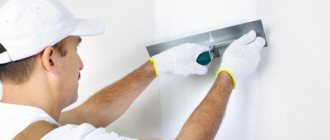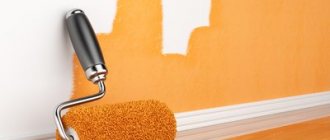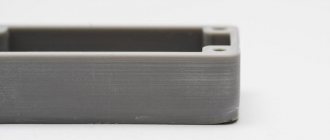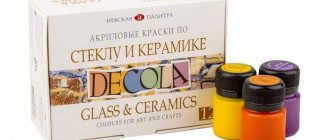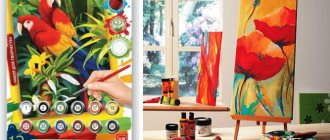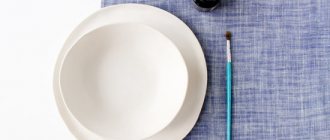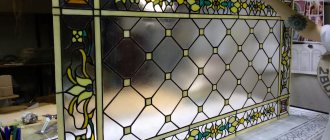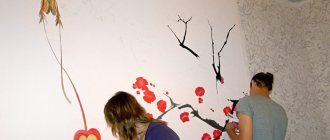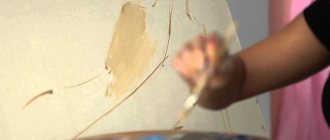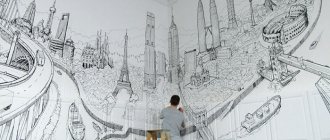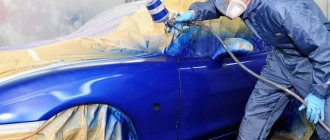Water-based paint
It is a generalized concept of paint and varnish products, divided into various subtypes. Contains pigments, special-purpose polymer substances, and water. Some varieties contain acrylic and silicone resins. The consistency required for painting the surface is obtained using solvents. The exact paint consumption per square meter depends on the type of surface being painted.
Advantages
Water-based paint is absolutely safe for humans, does not emit toxic fumes into the environment, and also:
- has no odor after drying;
- has an affordable price;
- simple and easy to apply.
Painting can be done using a roller or a ball-type brush. To obtain the desired shade, coloring pigments are added to the paint. The paint and varnish material is ideal for performing interior finishing work at temperatures from 5 degrees above zero. Drying quickly, it allows you to apply a new coat almost immediately after the first.
Varieties
The following types of water-based paint are available: mineral, silicate, silicone and acrylic. Each differs in composition and scope of application. The most expensive type is silicone, which fits and holds perfectly. The most affordable is water-based mineral paint, the main component of which is either cement or slaked lime. The advantage is that it perfectly paints any surface, but does not have a long service life due to its high susceptibility to negative external factors. The specific properties of the paint and varnish coating largely depend on the composition and subtype. Acrylic, in fact, is a type of water-based one. Its cost is in the average price range, and its scope is quite wide. It is used for painting plastered, brick and wooden surfaces.
Properties of water dispersion paint
In addition to water, dyes include fillers, pigments, binding polymers and substances that give the material additional properties. Aqueous dispersions are often sold in the form of a liquid paste, which is diluted with water immediately before use. It is recommended to dilute aqueous emulsions with oily solvents: drying oil or turpentine.
Main components
Water-based paints contain materials that determine their performance and performance characteristics. These include the following components:
- Fillers - tiny marble chips, talc or powdered chalk. These components are responsible for the hardness, wear resistance and other performance properties of the coating.
- Pigments - determine colors and shades.
- Binders and film formers are polymers that hold all components together and create a surface layer of paint after the water evaporates.
- Solvents: water - for an aqueous dispersion system, water and oil - for a water-based dye.
- Complementary components are substances that provide the necessary performance properties and improve the technical characteristics of the coating.
Depending on the additional additives, aqueous dispersions based on polyvinyl acetate, latex and acrylic are distinguished.
Paints containing PVA adhere perfectly to plastered surfaces, wood and concrete. They are inexpensive, easy to apply and dry quickly, but are not suitable for outdoor use and rooms with high humidity, as they are poorly resistant to dirt and weathering. Polyvinyl acetate dyes are perfect for finishing walls and ceilings indoors with moderate humidity.
Latex coating is more resistant to moisture and abrasion, is not afraid of contamination and can be used for painting kitchens and bathrooms.
Acrylic dyes have the best protective properties and resistance to external influences. They are not afraid of moisture and dirt. Acrylic compositions can be used indoors with high humidity and for painting external walls made of wood, brick and concrete.
Specifications
In addition to the composition, which largely determines the performance properties of the paint layer, the main characteristics of water-based paints are:
- viscosity;
- consumption to cover one square meter;
- temperature conditions during storage and application of paint;
- drying speed.
Viscosity determines the fluidity of a material and depends on the concentration of water. The viscosity of the dye for application with a brush or roller should be about 40-45 St, and for a spray gun - about 20 St.
Material consumption per square meter determines the ability to completely paint the surface in one layer. Aqueous dispersions have good hiding power, so on average from 170 to 220 ml are consumed per square meter. The indicator depends on the viscosity and characteristics of the surface being painted.
Water-based paints should not be frozen or used at sub-zero temperatures. It is undesirable to work with the material at temperatures below five degrees Celsius and at high air humidity.
Water-based dyes dry quickly. After 30-45 minutes the surface layer is no longer sticky, and after 8-12 hours the coating is completely dry.
Acrylic paint
It is an improved version of the water-based one. The composition of the paint and varnish material includes the following components: distilled water, polymer acrylic emulsion, dye. Polyacrylics with copolymers contained in the paint form a special protective film on the surface being painted. The paint and varnish composition is superior to other types in quality and durability. After painting, the base acquires an expressive and rich color that does not fade under the influence of ultraviolet rays and is not washed off due to high humidity. The water base ensures no odor after drying. To obtain a bright shade, the paint is applied in several layers. Acrylic paints are suitable for artistic painting. They are used in the design of design elements and the creation of original interiors. The composition can be diluted with water. To obtain a paste, the paint is diluted with a special compound. Paint and varnish material is often used for painting artistic paintings.
Advantages
Acrylic paint has many advantages, thanks to which it is widely used for painting various surfaces:
- the composition hardens in half an hour, and dries completely after a few days and much faster if the air temperature is high;
- the coating gives the surface a beautiful appearance, resistant to fading and washing off, which guarantees a long service life;
- the presence of a protective film, which provides not only durability, but also prevents rolling and cracking;
- the versatility of the paint allows the use of compositions for coloring, painting, and creating artistic canvases;
- the absence of toxic substances makes the material absolutely environmentally friendly;
- a variety of colors allows you to choose a color or shade for absolutely any interior;
- the absence of combustible and flammable components makes the paint fireproof.
Technical characteristics of acrylic compositions
Distinctive properties of the acrylic composition:
- viscosity (the mixture is distributed evenly, quickly fixed, and does not flow off the surface);
- low weight allows you to paint fragile materials (plasterboard);
- high hiding power (two layers are enough for the finishing coat).
The drying speed is affected by the air temperature and humidity in the room. Optimal indicators:
- temperature – above 15°C;
- humidity – 65%.
Advantages of the material
Painting walls with acrylic paint.
Main advantages:
- dries quickly (from 2 hours, it takes 2 days to dry completely);
- withstands washing and exposure to sunlight;
- no pungent odor;
- ease of application;
- good heat resistance (withstands temperatures down to -30°C);
- the resulting protective film prevents the appearance of cracks;
- resistance to temperature changes;
- absence of substances harmful to health;
- the ability to choose the desired color for the interior;
- long service life (at least 8 years);
- fire safety.
Disadvantages of acrylic solutions
Such negative points are important when choosing a material:
- high cost compared to other varieties;
- low vapor permeability, with a film thickness of 200 microns - about 0.0003 mg/(m*h*Pa).
The high cost is compensated by the hiding power: fewer layers are required to cover the surface.
What are the disadvantages of acrylic paint?
Of course, there are disadvantages to the paint coating, but they are quite insignificant if we compare them with the advantages. The disadvantages include the following:
- Price. The composition has a fairly affordable price, but it is higher than some other varieties. with the exception of silicone. However, given that there is no need to apply many layers, the consumption is much more economical. This makes up for the difference in price.
- Low vapor permeability. This property does not always matter. Concrete surfaces, which also have low vapor permeability, are almost universally used in ceilings.
Acrylic paints have no serious disadvantages. However, when choosing a paint and varnish material, you should take into account the purpose of the composition, and also purchase products from trusted brands.
Varieties
Acrylic paints are universal because they are available in several versions, each of which has its own purpose:
- Washable. Withstands from 1500 to 3000 wet cleaning cycles. Contains latex to resist moisture. Great for use in kitchens, bathrooms and kitchens.
- Atmospheric. Designed specifically for exterior painting work, they are characterized by increased resistance to external negative weather phenomena, including precipitation, high and low temperatures.
- Internal. Designed for interior decoration. They are characterized by high service life and abrasion resistance.
- Facade. Used for painting building facades. They are an excellent alternative to more expensive siding.
The choice of variety is directly determined by what surfaces are planned to be painted. This ensures the durability and reliability of the painted surface.
Technical characteristics of water-based acrylic composition
Standardization of technical characteristics is carried out by GOST 28196-89. The following indicators are under control:
- color;
- amount of pigments and resins;
- appearance of the film after drying;
- light fastness (resistance to UV rays);
- hiding power (affects material consumption);
- composition pH;
- wear resistance (service life more than 8 years);
- frost resistance;
- possibility of use at low temperatures;
- drying time for 1 layer.
The difference between water-based and acrylic paints
Water-based paint and varnish composition is used for painting both small and large areas. Almost all surfaces can be painted, but not metal ones. The mineral variety does not fit well on previously painted substrates. Acrylic paints, being more advanced, are resistant to high temperature and humidity. The presence of acrylic resins in the composition prevents abrasion, cracking, and fading under ultraviolet radiation. The coating retains its attractive appearance for a long time. Water-based paint is prohibited for use in rooms with high humidity and is unsuitable for external painting work. Acrylic, on the contrary, can be painted both inside and outside, regardless of humidity and temperature. The lack of resistance to moisture in water-based paint is the main difference between this composition and acrylic, which determines its wider distribution and use than the first.
Comparison
The main difference between acrylic paints and other types of water-based paints is that the former uses acrylic resin as a polymer base. In turn, for example, liquid glass is used in silicate water-based paints, and cement or lime is used in mineral paints. The noted advantages of acrylic paints - versatility, low gas permeability, resistance to chemical and temperature influences - are not characteristic of all water-based materials.
Likewise, many alternative water-based paints can be used where acrylic paints are not desirable. For example, when painting plaster (mineral paints come in handy here), when working in rooms with high humidity (in this case, silicate materials can be successfully used).
Acrylic paints in many cases are more expensive than other types of water-based paints that can be used in similar conditions.
Having determined what the difference is between acrylic and water-based paints, we will record the conclusions in the table.
Applying acrylic paint over water-based paint
It becomes possible only in cases where the surface does not have any visible damage, including peeling and swelling. When the base is completely intact, painting is carried out without any problems. If the old water-based paint is peeling, swollen, or damaged, it is not recommended to apply acrylic composition. It is better to completely remove the old coating to ensure quality painting.
The range of modern paint and varnish products pleases with its diversity any person who has started a renovation. Many people are faced with a choice of what to give preference to – water-based or water-dispersion paint. To do this, you need to determine what the difference is between them, and what important features are characteristic of each type.
Important features and advantages of water-based paints
When using water-dispersed paints, you should take into account what features are characteristic of them:
- the air temperature to use this type of coating must be more than +5°C;
- this paint dries completely two hours after application;
- This type of coating is capable of ideally filling small cracks and crevices, and therefore does not require too thorough preliminary preparation of surfaces.
Among the most important advantages that they have are:
- durability of the coating;
- excellent breathability;
- high resistance to temperature changes;
- non-exposure to aggressive household products;
- absence of toxic substances in the composition;
- compatibility with almost any type of surface, the only exception being metal, contact with which can cause corrosion;
- no unpleasant irritating odor.
Are there any differences?
Despite similar names, properties and compositions, there are minor differences between water-based and water-dispersion paints. Water-emulsion ones are characterized by better covering power, while water-dispersion ones are more durable. The cost of water-based paints is usually lower.
Knowing what properties and advantages both of these popular types of paints have, you will not be mistaken in your choice. The main thing is to give preference to coatings made by manufacturers with an impeccable reputation.
